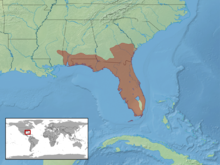Eastern indigo snake
| Eastern Indigo Snake | |
|---|---|
 |
|
| Scientific classification | |
| Kingdom: | Animalia |
| Phylum: | Chordata |
| Class: | Reptilia |
| Order: | Squamata |
| Suborder: | Serpentes |
| Family: | Colubridae |
| Genus: | Drymarchon |
| Species: | D. couperi |
| Binomial name | |
|
Drymarchon couperi (Holbrook, 1842) |
|
 |
|
| Synonyms | |
The eastern indigo snake (Drymarchon couperi) is a species of large nonvenomous colubrid snake native to the Eastern United States. It is of note as being the longest native snake species in the U.S.
The eastern indigo snake has even blue-black dorsal and lateral scales, with some specimens having a reddish-orange to tan color on the throat, cheeks, and chin. This snake received its common name from the glossy iridescent ventral scales which can be seen as blackish-purple in bright light. This smooth-scaled snake is considered to be the longest native snake species in the United States. The longest recorded specimen measured 2.8 m (9.2 ft). Unlike many snakes, mature male indigo snakes are slightly larger than females. A typical mature male measures 1.2–2.36 m (3.9–7.7 ft), with a reported average of 1.58 m (5.2 ft), and weighs 0.72–4.5 kg (1.6–9.9 lb), reportedly averaging 2.2 kg (4.9 lb). Meanwhile, a mature female typically measures around 1.1–2 m (3.6–6.6 ft) in length, averaging 1.38 m (4.5 ft), and weighs 0.55–2.7 kg (1.2–6.0 lb), averaging 1.5 kg (3.3 lb). In specimens over 2.6 m (8.5 ft), these snakes can weigh up to 5 kg (11 lb). Although the indigo snake is similar in average body mass, extremely large specimens of the bulky, co-occurring venomous eastern diamondback rattlesnake can outweigh them.
The eastern indigo snake was first described by John Edwards Holbrook in 1842. The species was considered monotypic with 12 subspecies until the early 1990s when it was elevated to full species status according to The Society for the Study of Amphibians and Reptiles, in their official names list.
The generic name, Drymarchon, roughly translates to “lord of the forest”. It is composed of the Greek words drymos (Δρυμός), meaning "forest", and archon (ἄρχων), meaning "lord" or "ruler".
The specific name is a latinization of the surname of American planter James Hamilton Couper (1794-1866). Couper brought Holbrook the type specimen from south of the Altamaha River in Wayne County, Georgia.
...
Wikipedia

